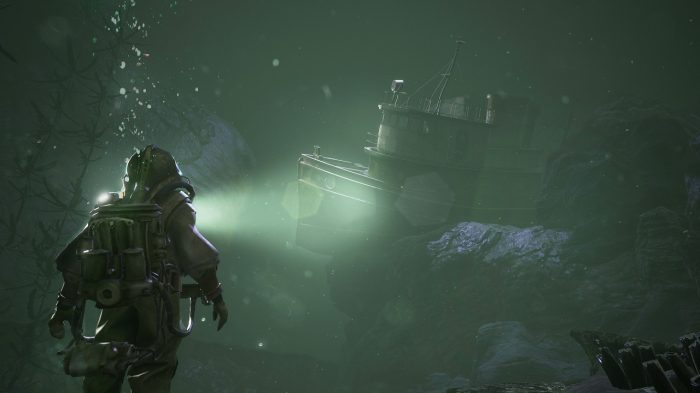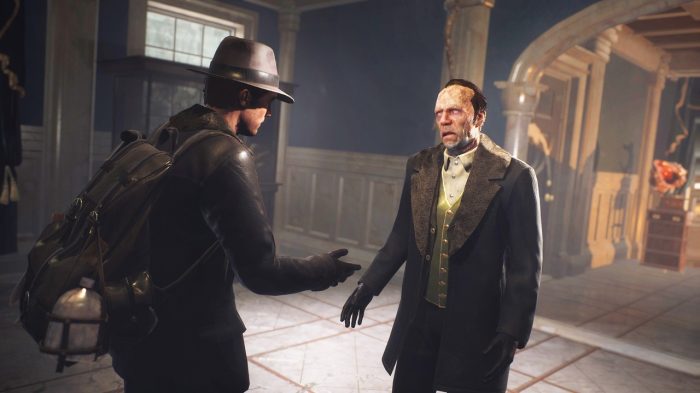Boy, is it good to see a Nintendo console receive a huge, open-world adventure game – and within just a short couple of months of the game appearing on other formats, at that.
The Sinking City takes us to the city of Oakmont, a dingy and violent place which harbours some sinister secrets, and which has a population which is either murderous, battling severe mental health difficulties, or both. Anyone with any inch of sanity remaining deserted the area at the time of The Flood, and the partially submerged town is now almost exclusively home to gang warfare and mystery.

Frogwares’ detective-action game has you play as private investigator Charles Reed, who has sailed to the city with a view to finding out the reasoning behind his visions, which are being shared by several of the townspeople. While a good amount of the population are human like Reed, others have noticeably different characteristics, with the wealthy Robert Throgmorton appearing ape-like and the Innsmouthers he detests so passionately looking like fish. Yes, you may have previously heard these names in the works of H. P. Lovecraft, and it is the Lovecraftian form of horror and atmosphere from which this game takes its storytelling inspiration.
And atmosphere is something the game does do well. While the entire town is surrounded in a blueish hue (a little more colour wouldn’t have gone amiss, despite the desolate themes that were intentional as the town seeks to recover from its flood damage), players will quickly become accustomed to key locations like the police station, town hall and hospital, which must all be visited frequently to consult their archives to figure out mission-based clues. But the atmosphere and immersion could have been better – the city is rather barren, and the NPCs walking around lack character.

Building layouts are frequently repeated with minor alterations, as is the gameplay in a lot of the side missions, which have you finding addresses on the map, visiting, clearing them out of monsters and then collecting a key item.
Fast-travel phoneboxes are located all over the map and must be visited to activate them for the first time, but the movement speed on foot is slow and frustrating. The submerged bits of town can be navigated by boat, but it’s far too easy to accidentally get the boat stuck on a jetty or outlying bit of land.

But it’s the underwater sections which are the least interesting bits of The Sinking City – they all consist of walking at a cumbersome pace through very dark areas, dodging hot steam flows and trying not to stare at garish underwater enemies for too long to protect Reed’s sanity. Sanity and health are the two main meters which you’ll need to stay on top of, though they can easily be replenished by picking up the necessary crafting items in storage boxes throughout the city. You’ll rarely find yourself running low on these, but bullets, which are the unofficial currency of Oakmont, are scarcer.
Combat in The Sinking City isn’t great. There is at least motion controls, but using R for the melee attack is clumsy, and you’ll find Reed throwing air-shots left, right and centre as enemies flit around you at a speed faster than you can turn. There are about five or six different enemy types which you’ll see over and over, and only one one-off boss of any kind appearing midway through the game. None of them pose a huge challenge, but your wrestling match will be with the controls rather than with them, which isn’t what this reviewer was hoping to report back.

Such is the repetition employed by the gameplay of the tasks – get a vague clue, head to an archive to decipher it, mark the point on your map and then head there and shoot some monsters – the detective sections are a welcome break. Reed needs to examine every single aspect of a room to get the ‘All Evidence Collected’ marker for the map, and in a lot of situations he can use his ability to see into the past to see a series of three or four events which the player must place into chronological order in order to establish the chain of events which led to the building’s current predicament. Some of these are pretty logical, but others are on the other end of the spectrum, which can lead to a bit of irritation, for sure. It’s fortunate that the more poorly-written ones are few and far between.
But this is an engrossing experience while it lasts. While Breath of the Wild showed that the Switch can do much clearer visuals than we see here, that doesn’t take you out of the atmosphere, and with strong voice-acting and music to boot, The Sinking City will hopefully end up being one of many open-world experiences on the Switch now that the system has shown what it can do.
The Sinking City £44.99
Summary
The Sinking City does atmosphere and immersion really well, and we like that a lot. It doesn’t do its combat and handling as well, though, or it would be getting a higher score.

